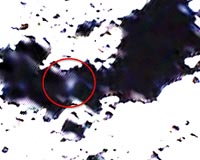 |
Bonn, Germany (SPX) Nov 24, 2009 Nowadays, solar eclipses are seen as a fascinating natural phenomenon. In earlier times, people viewed them instead as something threatening, since the Sun provides us with light and heat, without which life on Earth could not flourish. However, the cause of solar eclipses is now generally known: On its orbit around the Earth, the Moon passes between Earth and Sun, causing darkness lasting a few minutes. In other words, it casts its shadow on Earth, and then moves away again. The Moon orbits the Earth every 28 days - so why is there not a solar eclipse once a month? This is due to the fact that the Moon's orbital plane around the Earth is set at a slight angle to the Earth's own orbital plane around the Sun. A relative angle of inclination of just 5.1 degrees between these two orbital planes is all that is required for the Moon to cause a solar eclipse on Earth only twice a year or so. Lunar eclipses are governed by the same principle as solar eclipses: In this case however, the Earth 'slides itself' between the Moon and the Sun. At these points, the Sun, Earth and Moon are arranged in an almost straight line, and the core shadow or 'umbra' of the Earth passes over the surface of the Moon. Due to the fact that the diameter of the Earth is about 4 times greater than the diameter of the Moon, the shadow cast by Earth is also about 4 times larger. As a consequence, the period of darkness on the surface of the Moon is correspondingly longer.
Lunar eclipse on Earth = solar eclipse on the Moon However, those astronauts would experience a second spectacle: A solar eclipse caused by the Earth - the Sun disappearing behind the dark disc of the Earth. When Earth inhabitants witness a lunar eclipse, Moon inhabitants would, simultaneously be witnessing a solar eclipse. Share This Article With Planet Earth
Related Links German Aerospace Center (DLR) Mars News and Information at MarsDaily.com Lunar Dreams and more
 The Lunar Oasis
The Lunar OasisSydney, Australia (SPX) Nov 20, 2009 2009 will go down in history as one of the greatest years for lunar exploration. We were stunned by the discovery that the sun-drenched lunar surface, once thought to be bone dry, hosts small traces of water! Orbital observations of the Moon's polar regions revealed areas that are probably the coldest regions in the solar system, with temperatures plunging below that of Pluto! With all thi ... read more |
|
| The content herein, unless otherwise known to be public domain, are Copyright 1995-2009 - SpaceDaily. AFP and UPI Wire Stories are copyright Agence France-Presse and United Press International. ESA Portal Reports are copyright European Space Agency. All NASA sourced material is public domain. Additional copyrights may apply in whole or part to other bona fide parties. Advertising does not imply endorsement,agreement or approval of any opinions, statements or information provided by SpaceDaily on any Web page published or hosted by SpaceDaily. Privacy Statement |